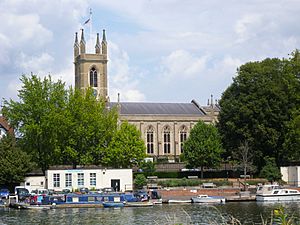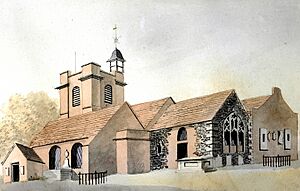St Mary's Parish Church, Hampton facts for kids
Quick facts for kids St Mary's Parish Church, Hampton |
|
|---|---|
| St Mary the Virgin, Hampton Upon Thames | |

A view of St Mary's, from the River Thames (2009)
|
|
| 51°24′47″N 0°21′41″W / 51.413019°N 0.361261°W | |
| OS grid reference | TQ1394669560 |
| Location | Thames Street, Hampton, London TW12 2EB |
| Country | England |
| Denomination | Church of England |
| Membership | 246 (2009) |
| History | |
| Status | Parish church |
| Founded | 1342 |
| Dedication | St Mary the Virgin |
| Consecrated | 1 September 1831 |
| Architecture | |
| Functional status | Active |
| Architect(s) | Edward Lapidge |
| Style | Gothic |
| Groundbreaking | April 1830 |
| Completed | September 1831 |
| Construction cost | £9,484 1s 2d |
| Administration | |
| Parish | St Mary, Hampton |
| Deanery | Hampton |
| Archdeaconry | Middlesex |
| Episcopal area | Kensington |
| Diocese | Diocese of London |
| Province | Canterbury |
St Mary's Parish Church in Hampton is an Anglican church. It is located in Hampton, a town in the London Borough of Richmond upon Thames.
Contents
Where is St Mary's Church?
St Mary's Parish Church stands on Bell Hill in Hampton. It is at the meeting point of two main roads, the A308 and A311. These roads lead to nearby towns like Twickenham, Kingston upon Thames, and Sunbury-on-Thames. The church marks the very old center of Hampton.
In the mid-1800s, new houses were built north of the village. This area became known as New Hampton, and later Hampton Hill. In 1863, a new church parish, St James, Hampton Hill, was created. The Hampton parish was divided again in 1929 when the All Saints parish was formed.
A Look at St Mary's Church History
The land where St Mary's Church stands might have been home to a Roman-British chapel long ago. We know for sure that a place of worship has been here for at least 650 years. Records show that in 1342, the land became owned by the Priory of Takeley in Essex. It was described as a church belonging to that monastery.
Before 1342, there might have been a simple wooden building. Or, church services could have been held under a very old yew tree. This tree stood in the churchyard until 1829.
The Old Church Building
The first church we have records for was built from flint and stone. Inside, there were galleries on the north, west, and south sides. A special area was set aside for the choir and musicians. The church also had a three-level pulpit. The lowest level was for the clerk, the middle for reading lessons, and the top for sermons. The royal family had their own special pew in the north gallery.
The old church also had a school room. It provided a teacher for Hampton School starting in 1557. During the time of King Henry VIII, the main part of the church (the nave), the south side (south aisle), and the entrance (porch) were rebuilt with brick. This was because they were old and unsafe. The original flint and stone parts, the chancel and tower, remained.
In 1671, the tower also became unsafe. A new brick tower was built. King Charles II gave £350 to help with this. In 1726, the north aisle and the vault beneath it were added. A vestry room was also built at the church's north-west corner. King George I gave £500 for this expansion.
This version of the church was known as Hampton's "brick church." It had comfortable, freshly painted benches in the churchyard. Many people attended services, with twelve or more carriages waiting outside. A famous person who worshipped there was George FitzClarence, 1st Earl of Munster.
Important memorials from the old church were saved and put in the new one. These included memorials for Susannah Thomas (died 1731) and Sibel Penn (died 1562). Sibel Penn was the nurse to King Edward VI. There were also memorials for Edmond Pigeon and his son Nickolas, who worked at the Jewel House. Another was for Huntington Shaw (died 1710), who designed ironwork at Hampton Court Palace.
The Current Church Building
As Hampton's population grew, the church leaders decided the old building needed to be bigger. An early plan in 1821 was just to extend it. The King promised money if seats were provided for people from Hampton Court Palace. But not enough money was raised from other sources, so the project was put off.
For the next eight years, different plans and competitions were held to design a new building. The old church finally closed on December 27, 1829. The churchgoers then moved to the Great Hall of Hampton Court Palace while the church was torn down.
Prince William, Duke of Clarence, laid the new foundation stone on April 18, 1830. The new building was officially opened on September 1, 1831. This event was so important that Princess Adelaide, Prince George, and his sister Princess Augusta attended. The roads were blocked with carriages for a quarter of a mile. Prince William, who became King William IV a week later, gave the church its organ.
By 1879, the churchyard was full. From then on, burials took place at the new Hampton Cemetery. This cemetery opened that same year on Holly Bush Lane.
Also in 1879, the church organ was moved. It was originally in the middle of the west gallery. It moved to its current spot in the north-west corner when a robed choir started. The organ was rebuilt in 1901.
The time when Prebendary Digby Ram was in charge (1882–1911) saw the church become very active again. The building was also improved further. In 1885, the old box pews were removed and replaced with the ones you see today. The main part of the church, the nave, was also refurbished.
To show the new life in the parish, the church was reopened by Bishop Walsham How. Right after, the first Confirmation service since 1831 took place. To celebrate Queen Victoria's Golden Jubilee in 1887, the chancel was built. The impressive east window by Heaton, Butler and Bayne was also added. It was inspired by the Te Deum hymn. The window on the north side of the chancel shows the 'Magnificat', and the one on the south side shows the ‘Nunc Dimittis’.
The stained-glass windows on the north and south walls were made by Eric Fraser. The north wall window shows the Annunciation. The south wall window shows the four Archangels: Michael, Raphael, Gabriel, and Uriel.
In 1920, the church was reorganized and restored again. A war memorial screen was added to remember those who died in the First World War. Then, in 1931, new choir and clergy stalls were added to match the screen.
A striking painting on the west wall was done by Eric Fraser's son, Rev Geoffrey Fraser. He painted it in 1952–53. The left side shows people from local history. The right side shows church members from that time. Above the River Thames, the figure of Christ rises.
In the 1960s, attention turned to the north aisle. A small chapel was created there. It had an altar table, a reredos (a screen behind the altar), altar rails, and stainless steel fittings. This new chapel was officially opened in 1967.
St Luke's Chapel, located in the west porch, was dedicated in 1990. Its doors have etched figures of the Virgin Mary and the Archangel Gabriel. These figures are based on drawings by Eric Fraser and were given by his family in his memory.
In the late 1990s, a small kitchen and toilet were added in the north porch. Inside the church, a small stage area was created in front of the screen. Floodlights were installed for the Millennium. In 2005, after a fundraising effort, the outside stonework was repaired and cleaned. In 2013, the toilet area was updated to include two cubicles. At the same time, the side chapel was moved to the south aisle. A flexible space with chairs was created in the north aisle.
Churchyard and Notable Burials
The churchyard has an unusual, Grade II listed, pyramid-shaped tomb. It belongs to John Greg (1716–1795), who owned plantations in Dominica, and his wife Catharine, who died in Hampton in 1819.
Other notable people buried here include:
- Huntingdon Shaw (1660–1710), a blacksmith.
- Samuel Lapidge (died 1806), who helped Capability Brown and later became head gardener at Hampton Court Palace. He was the father of Edward Lapidge (1779–1860), an English architect who designed St Mary's Church. Edward Lapidge is also buried here.
- George Lowe (1716–1758), who was the master gardener to King George II. He was also the father of George Lowe (born 1740), who planted the Great Vine at Hampton Court Palace in 1768.
- George FitzClarence (1794–1842), a nobleman and soldier.
- Sir William Wightman (1784–1863), a judge.
- Lord Alfred Paget (1816–1888), a soldier, courtier, and politician.
- Sir James Mantle Greenwood (1902–1969), an advertiser and local politician. He received a CBE in 1956 and was knighted in 1962 for his public service in London.
- Hugh Campbell (1837–1877), Captain of the royal yacht HMY Victoria and Albert. He was born in Long Ditton and died of typhoid at Hampton Court Palace.
Church Life Today
St Mary's Church still has an active group of people who attend services. It is part of the "Churches Together around Hampton" group. In 2013, St Mary's opened a primary school on Oldfield Road. This was part of the Free School programme.
Hampton School holds its Founder's Day gathering at the church each year.
St Mary's in Literature
The church is briefly mentioned in Jerome K Jerome's funny 1889 novel, Three Men in a Boat.
Harris wanted to get out at Hampton Church, to go and see Mrs. Thomas’s tomb.
“Who is Mrs. Thomas?” I asked.
“How should I know?” replied Harris. “She’s a lady that’s got a funny tomb, and I want to see it.”
The church does have a memorial for Susanna Thomas (died 1731) on the east wall of the south aisle. Paul Goldsac, in his book River Thames: In the Footsteps of the Famous, says there isn't much that is funny or special about it. However, the tomb has a very fancy, old-fashioned style with partly draped female figures. This might have surprised some people in Victorian times and amused others, including J K Jerome. So, the tomb could be seen as "funny" because it was unusual and entertaining.



